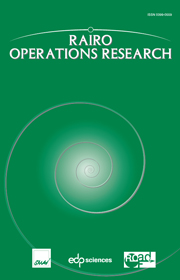Article contents
À propos de la signification des dépendances entre critères : quelle place et quels modes de prise en compte pour l'aideà la décision ?
Published online by Cambridge University Press: 22 July 2009
Abstract
Soit F une famille de critères conçue pour asseoir un modèle de préférences global sur un ensemble A d'actions potentielles (ou alternatives). On se place ici dans une perspective d'aide à la décision et dans l'hypothèse où des dépendances (encore appelées interactions) sont susceptibles d'exister entre certains des critères de F. On commence (cf. Sect. 2.1) par préciser ce que signifie l'affirmation "il existe des dépendances entre certains des critères de F" (Déf. 1). On s'intéresse ensuite à deux formes classiques de dépendances (cf. Sect. 2.2). Dans la Section 3, on cherche à apporter des éléments de réponse à la question : comment mettre en évidence les dépendances s'il en existe et comment les rendre intelligibles pour les parties prenantes au processus de décision ? On définit trois types de situations particulièrement dignes d'intérêt car aisément intelligibles et faciles à cerner. Dans la section suivante, on examine les possibilités qu'offrent un certain nombre de modèles d'agrégation pour prendre en compte explicitement des dépendances. On met notamment en évidence (cf. Sect. 4.2) les possibilités et limites de l'intégrale de Choquet. Tout au long de l'article, des exemples sont introduits pour illustrer les propos.
Keywords
Information
- Type
- Research Article
- Information
- Copyright
- © EDP Sciences, ROADEF, SMAI, 2009
References
- 15
- Cited by

